A non-profit small group trip organised and led by Adrian Hoskins
From the massive Petronas twin towers of sophisticated Kuala Lumpur to the wooden huts-on-stilts of the Orang Asli aboriginal villages, Malaysia is a country of great contrast and amazing variety. Much of it is dominated by an unrelenting panorama of oil palm, rubber and tea plantations, yet here also is the vast primeval rainforest of Taman Negara, which was unaffected by the Ice Ages, and has remained virtually unchanged for 130 million years. More tree species can be found in a single hectare of the Taman Negara than in the entire United States. It is one of the few lowland areas of Malaysia that has so far escaped the ravages of logging.
In the dry season the days are sunny and sweltering, but by late afternoon there are often torrential downpours, accompanied by incredibly loud cracks of thunder that have you jumping out of your skin. In the wet season the rains can continue for weeks at a time, and river levels can rise by 20 feet.
At all times the forest is alive with sound – melodious birds, chirping frogs, and the all pervading wail of huge cicadas. Wild pigs scuffle through the undergrowth, snakes and lizards slither from the sides of the trails as you approach. Leeches attach themselves to your arms and legs, gorging themselves on your blood. Mosquito bites have you itching like crazy, and you constantly trip over tree roots as you negotiate the steep slippery trails.
Finding butterflies can be difficult, but visiting Taman Negara is all about challenge, and the rewards are great for those willing to make the effort. Along the dark trails, elusive glittering blue Caeruleans zip acrobatically through the undergrowth.
Every now and then you glimpse a huge black and golden-yellow Birdwing high in the trees. Dazzling orange multi-tailed Lycaenids appear out of nowhere only to disappear just as quickly. The sheer variety of the butterflies is nothing short of incredible – you can expect to see everything from tiny Grass Blues to the huge dazzling 8″ Rajah Brooke, and just about every shape, colour and pattern imaginable.

Sungai Woh river, Bukit Tapah – Adrian Hoskins
On the first week of our tour we visited several sites at various altitudes on the western slopes of the hills in Perak. The second week was spent entirely at Taman Negara. You could easily spend a lifetime in Malaysia and still only scratch the surface, but we had just 2 weeks to sample the fauna. We began by visiting Tapah.
Cloudy conditions reduced butterfly sightings on the first day but we were thrilled to see the stunning orange and white multi-tailed Branded Imperial Eooxylides tharis, the Great Orange tip Hebomoia glaucippe, and the magnificent Common Birdwing Troides helena – a huge species with jet black forewings and vivid metallic yellow hindwings. By the end of the day our species list had hit the 50 mark, and rose by an additional 10-15 species per day as we explored nearby Bukit Tapah on the following 2 days.
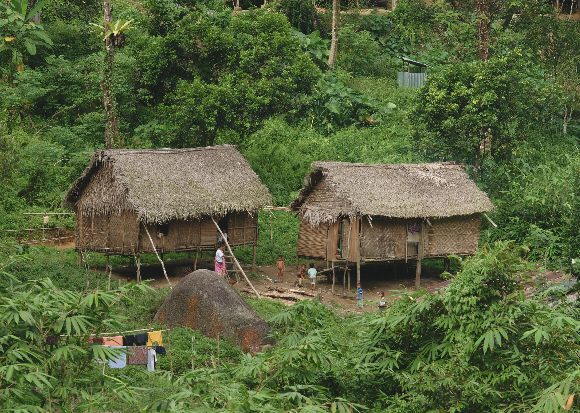
Orang Asli village, Bukit Tapah – Adrian Hoskins
Close to the Orang Asli settlements we encountered several groups of mud-puddling Eurema Grass Yellows, amidst which were usually a couple of Red-spot Sawtooths Prioneris philonome and various other Pierids. Swallowtails also gathered to drink at damp patches of ground, and included several Graphium species and the gorgeous Red Helen Papilio helena. O
ther species we found included the pretty orange Yamfly Loxura atymnus, the intricately patterned Mapwing Cyrestis maenalis, and the Autumn Leaf Doleschallia bisaltide, which as it’s name suggests has an underside which bears a remarkable resemblance to a fallen dead leaf.
Although butterflies were our primary interest there was much else to see, including many brightly coloured dragonflies, beetles and bees. We also found a huge metallic green jewel bug, several pink-winged stick insects, and impressive reptiles which included large bright green lizards and a heavily armoured 18″ iguana.

Sungai Woh river, Bukit Tapah – Adrian Hoskins
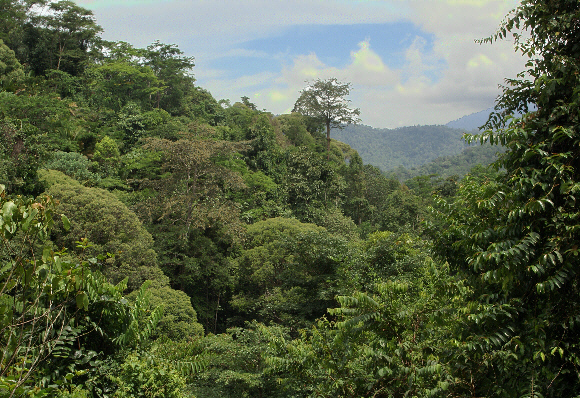 hill forest, Bukit Tapah – Adrian Hoskins
hill forest, Bukit Tapah – Adrian Hoskins
On day 4 we headed up to the cool forests of the Cameron Highlands. Near Ringlet we found 2 very attractive Riodinids – the pretty reddish Punchinello Zemeros flegyas, and the delightful tailed species Abisara neophron. In clearings and quarries we found several Long-tailed Blues Lampides boeticus, and the lovely silvery blue Caerulean Jamides celeno. Prettiest of all however was the Purple Sapphire Heliophorus epicles – a relative of the Coppers, marked on the upper wings with purple and orange, and with the underside bright yellow with red margins.
As we reached the higher altitudes of Tanah Rata temperatures dropped and butterflies became much harder to find. At Robinson Falls however we saw some interesting Satyrines including the white-barred Lethe verma and several of the attractive striped ringlets Ragadia makuta.
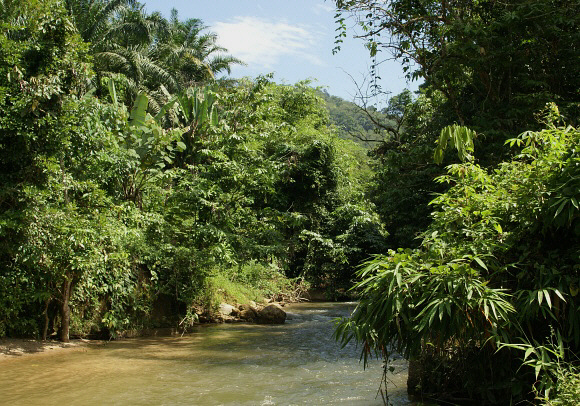
lowland rainforest, Gopeng – Adrian Hoskins
We spent the next 3 days based at Gopeng, taking daily excursions into the surrounding hills. Most of the lower slopes were covered in oil palm plantations where species diversity was expectedly very low. Nevertheless the proximity to the rainforest meant that there were still many beautiful butterflies to be found in the sunnier glades including the Yellow Glassy Tiger Danaus aspasia, the Oriental Short-tailed Blue Everes lacturnus, and the stunning striped Silverline Spindasis lohita.
The higher slopes have so far escaped the ravages of the oil palm industry and retain natural forest cover, dotted with Orang Asli settlements. We visited a small waterfall where a trio of Tree Nymphs Idea lynceus entertained us.
These huge butterflies, like white handkerchiefs marked with black polka dots, fluttered gently above our heads but never settled close enough to permit photography. When seen in flight they are extraordinarily graceful, and to watch them floating tantatisingly around us was one of the highlights of our time at Gopeng.
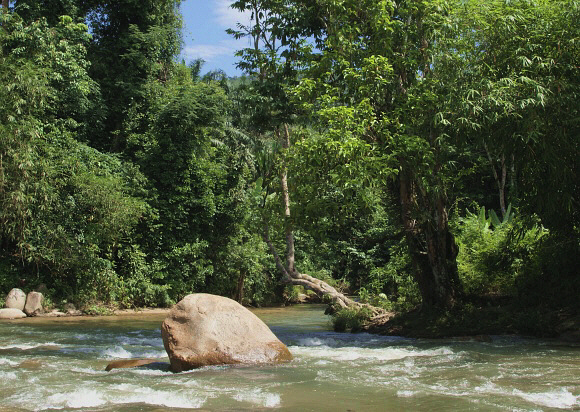
lowland rainforest, Gopeng – Adrian Hoskins
On our last day in the area we visited a Rafflesia conservation area at Ulu Gerok. Butterflies were diverse and abundant but we were saddened to discover that hundreds were being slaughtered daily by the local Orang Asli women and children who had laid dozens of crude traps along the forest trails. They used a sweet sticky solution to attract the butterflies to the ground, and used nets to catch all the Swallowtails and other brightly coloured species that came within reach. Any butterfly which landed on the ground however became trapped by the sticky bait which literally glued their wings together. The area around each trap was consequently littered with the damaged corpses of dozens of species.
Miraculously the Orang Asli had failed to discover what was without doubt one of the most amazing butterfly spectacles I have ever seen – a massive group of over 100 pristine Rajah Brooke’s Birdwings Trogonoptera brookiana settled on a small patch of ground on a quiet forest track. No photograph, video clip or verbal description can begin to do justice to the incredible beauty of these creatures, and to see such a huge aggregation was a sight guaranteed to blow the mind of the most experienced butterfly enthusiast.
Try to imagine 100 butterflies, each measuring almost 8 inches across, a quivering mass of shimmering iridescent green wings, packed together on a patch of ground the size of a small dining table. Then try to imagine the thrill of being so close that you could reach down and touch them.
After taking a few photographs you edge gently away but the whole group erupts into flight, and you are surrounded by a swirling mass of glittering green wings. You freeze on the spot, hoping not to scare them away, and they respond by gliding closely around you. Then one by one they resettle on the ground until they encircle you. At first they nervously quiver and flutter, but after a couple of minutes they all relax and spread their glorious wings. You are mesmerised, and the huge privilege of such an experience is something you never forget.
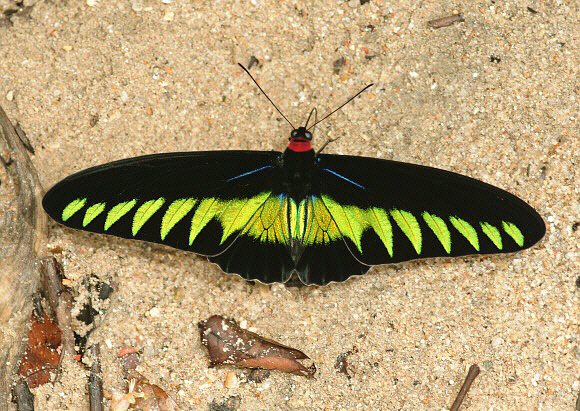
Rajah Brooke’s Birdwing, Trogonoptera brookiana – Adrian Hoskins
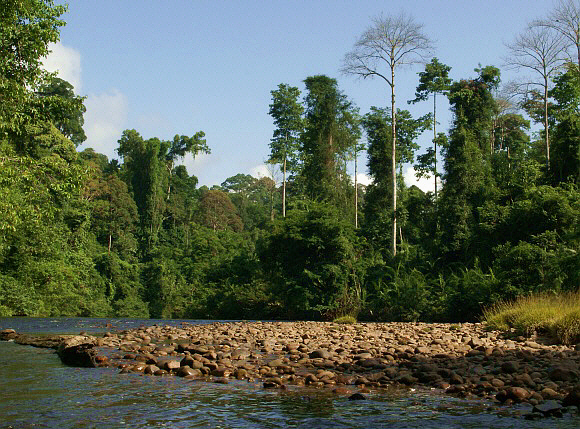 Sungai Tahan river, Taman Negara – Adrian Hoskins
Sungai Tahan river, Taman Negara – Adrian Hoskins
We spent our second week based at Kuala Tahan in Taman Negara national park. The 4 hour drive from Kuala Lumpur provided ample evidence of the affluence of the country, with hundreds of miles of new roads, and new urban and industrial developments under construction everywhere. Much of the country’s wealth comes from it’s oil palm industry, and sadly this has had a very detrimental effect on the environment, not only in Malaysia itself, but also in Africa and South America where Malaysian corporations are buying up vast quantities of land for oil palm production.
50 years ago the lowlands of Malaysia were largely covered in rainforest, but oil palms now reach as far as the eye can see in every direction. The result is that a sq kilometre of land that may previously have supported as many as 400 butterfly species is now only capable of supporting a dozen. Nowhere is this more noticeable than at Kuala Tahan, where land on one side of the Sungai Tembeling river is severely degraded, while the other side is covered in the pristine rainforest of Taman Negara.
We arrived mid afternoon and walked a couple of trails close to park HQ. In light gaps we found the exquisite long-tailed hairstreaks Drupadia ravindra and Zeltus amasa, along with 2 or 3 unidentified Arhopala Oakblues, and the purple-winged Terinos clarissa.
Just before dusk the Allotinus Darkies became active, the males taking up perching positions on low plants from which they fly up to intercept passing females. These butterflies although not especially attractive have a fascinating biology – the larvae are carnivorous, feeding on aphids, coccids and membracids; and the adult butterflies feed in the company of ants, on sugary secretions which the ants milk from aphids.
Finding butterflies on the trails is hard work. For most of the morning they fly high in the forest canopy, and most species only descend to the understorey in early afternoon. Even then they are usually seen as singletons, often just a fleeting glimpse as they settle momentarily on a leaf. The jungle is immense. It can take over a week to cover some of the longer trails.
It is oppressively hot and extremely humid – so much so that camera lenses and spectacles mist up within seconds, and you are drenched in sweat within minutes of setting out.
Photographing butterflies in these circumstances is to say the least, challenging. Patience and dedication are essential, as is a sense of humour – on many occasions we tripped over tree roots and crashed into the undergrowth, no doubt causing amusement to the onlooking butterflies. On one occasion when crossing a rickety bridge I became so distracted by a passing Birdwing that I put my foot through a broken slat and fell through into a river. Luckily I managed to avoid broken bones, and somehow held on to my camera, which survived the ordeal intact.
Although there are risks on the trails, and certainly more than a little discomfort, the rewards are great – in addition to a large number of butterfly species we also saw leaf monkeys, langurs, squirrels, wild pigs, sambar and barking deer, monitor lizards, iguanas, flying lizards, several snakes, fish eagles, kingfishers, giant millipedes, katydids, stick insects, bright red dragonflies, and myriads of ants and termites.
On some occasions we took the opportunity to explore the tributaries of the Sungai Tembeling by motorised longboats. These 4 seaters can seem a little unstable as you clamber on board, but the boatmen are highly skilled at navigating the shallow streams and small rapids, and once you are on the move there is little danger of overturning. The odd splash is inevitable however so it pays to have a waterproof bag to protect cameras and binoculars.
The short trip along the Sungai Tahan is one of the most beautiful river journeys in the world. The banks of the shallow blackwater stream are lined with giant Neram trees leaning far out over the water. Dappled sunlight filters through the foliage, dazzling blue and orange kingfishers dart across your path, brilliant metallic green damselflies dance over the water, and every now and then you glimpse a deer on the river bank, or a giant water monitor lizard basking on a half-immersed log.
After about 40 minutes the boat reaches the rapids at Lata Berkoh and can go no further. There, on the rocky beach are hordes of beautiful Graphium sarpedon swarming in groups of 20-30 to imbibe mineralised moisture. They have chocolate wings with translucent turquoise ‘windows’, and look like flotillas of miniature sailboards. The Five-bar Swordtail Pathysa antiphates is an even more stunning Lata Berkoh species with white wings that are marked underneath with bright green and orange.
Other species seen at Lata Berkoh included several yellow Pierids such as Dercas verhuelli, Catopsilia pyranthe and Eurema simulatrix. To my eyes the most delightful species were probably the lightning fast Dragontails which buzzed around the waters edge. These miniature relatives of the Swallowtails have transparent wings banded with black and white, and have incredibly long rudder-like tails. There are 2 species – Lamproptera curius and L. meges – the former appears whitish in flight, while the latter has a distinctive greenish appearance.
To summarise, our trip to West Malaysia was great fun, and enabled us to record and photograph over 170 species of butterfly. It’s difficult to pick a “butterfly of the trip”, simply because the variety of shapes, colours and patterns was so vast – how can you choose between the huge and incredibly beautiful Rajah Brooke’s Birdwing, and the fragile multi-tailed hairstreaks such as Eooxylides tharis or Drupadia ravindra ?
We hope to organise another trip to this fascinating destination soon !
